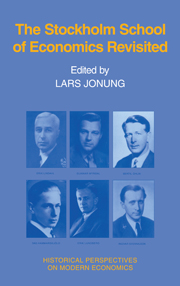Book contents
- Frontmatter
- Dedication
- Contents
- Preface
- List of Contributors
- Dramatis Personae at the end of 1937
- Introduction and Summary
- Part I The roots
- Part II The approach of the Stockholm School
- Part III The impact of the Stockholm School
- 15 The Swedish influence on Value and Capital
- 16 The London School of Economics and the Stockholm School in the 1930s
- 17 Thoughts on the Stockholm School and on Scandinavian economics
- 18 Ragnar Frisch and the Stockholm School
- 19 The late development of the Stockholm School and the criticism from John Åkerman
- Part IV What remains of the Stockholm School?
- The Stockholm School: A non-Swedish bibliography
16 - The London School of Economics and the Stockholm School in the 1930s
Published online by Cambridge University Press: 05 July 2013
- Frontmatter
- Dedication
- Contents
- Preface
- List of Contributors
- Dramatis Personae at the end of 1937
- Introduction and Summary
- Part I The roots
- Part II The approach of the Stockholm School
- Part III The impact of the Stockholm School
- 15 The Swedish influence on Value and Capital
- 16 The London School of Economics and the Stockholm School in the 1930s
- 17 Thoughts on the Stockholm School and on Scandinavian economics
- 18 Ragnar Frisch and the Stockholm School
- 19 The late development of the Stockholm School and the criticism from John Åkerman
- Part IV What remains of the Stockholm School?
- The Stockholm School: A non-Swedish bibliography
Summary
Whereas the Stockholm School has been defined as a “school,” it is not so easy to define the London School of Economics (LSE) as such. If one were to attribute such a definition to the LSE, it would not be in the field we are concerned with here – that of analytical deductive economics. The story of the Stockholm School and the LSE is best treated on the level of the interaction of individual members. However, the role played by Swedish ideas can best be demonstrated in the context of the battle of ideas that was going on in the 1930s and led to the establishment of Keynesian economics as the principal economic doctrine of the post–World War II era.
The material is rich and deserves a fuller account than can be accorded to it here. There is the influence on Hayek, which is treated in this volume by David Laidler; the influence on John Hicks, of which we also have a more direct account in this volume; and the relations between Gunnar Myrdal and Friedrich Hayek that culminated in their obtaining a joint Nobel Prize. The most interesting story, as far as our subject is concerned, is that of Brinley Thomas, who also gives a personal account of it himself (see Thomas, 1988). Brinley Thomas's lectures on Swedish economics at the LSE in the interwar period had an influence on George L. S. Shackle, who, as a result, changed the subject of his thesis.
- Type
- Chapter
- Information
- The Stockholm School of Economics Revisited , pp. 377 - 389Publisher: Cambridge University PressPrint publication year: 1991
- 8
- Cited by

